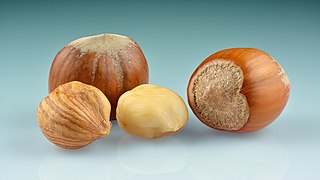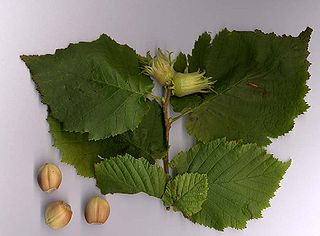Related Research Articles

Betulaceae, the birch family, includes six genera of deciduous nut-bearing trees and shrubs, including the birches, alders, hazels, hornbeams, hazel-hornbeam, and hop-hornbeams numbering a total of 167 species. They are mostly natives of the temperate Northern Hemisphere, with a few species reaching the Southern Hemisphere in the Andes in South America. Their typical flowers are catkins and often appear before leaves.

A nut is a fruit consisting of a hard or tough nutshell protecting a kernel which is usually edible. In general usage and in a culinary sense, a wide variety of dry seeds are called nuts, but in a botanical context "nut" implies that the shell does not open to release the seed (indehiscent).

The hazelnut is the fruit of the hazel tree and therefore includes any of the nuts deriving from species of the genus Corylus, especially the nuts of the species Corylus avellana. They are also known as cobnuts or filberts according to species.

Hazels are plants of the genus Corylus of deciduous trees and large shrubs native to the temperate Northern Hemisphere. The genus is usually placed in the birch family Betulaceae, though some botanists split the hazels into a separate family Corylaceae. The fruit of the hazel is the hazelnut.

Corylus avellana, the common hazel, is a species of flowering plant in the birch family Betulaceae, native to Europe and Western Asia. It is an important component of the hedgerows that were, historically, used as property and field boundaries in lowland England. The wood was traditionally grown as coppice, with the poles cut being used for wattle-and-daub building, and agricultural fencing.

Corylus maxima, the filbert, is a species of hazel in the birch family Betulaceae, native to southeastern Europe and southwestern Asia, from the Balkans to Ordu in Turkey.

A catkin or ament is a slim, cylindrical flower cluster, with inconspicuous or no petals, usually wind-pollinated (anemophilous) but sometimes insect-pollinated. They contain many, usually unisexual flowers, arranged closely along a central stem that is often drooping. They are found in many plant families, including Betulaceae, Fagaceae, Moraceae, and Salicaceae.

Corylus colurna, the Turkish hazel or Turkish filbert, is a deciduous tree native to southeast Europe and southwest Asia, from the Balkans through northern Turkey to northern Iran.

Corylus cornuta, the beaked hazelnut, is a deciduous shrubby hazel with two subspecies found throughout most of North America.
EFB may refer to:
Pseudomonas avellanae is a Gram-negative plant pathogenic bacterium. It is the causal agent of bacterial canker of hazelnut. Based on 16S rRNA analysis, P. avellanae has been placed in the P. syringae group. This species was once included as a pathovar of Pseudomonas syringae, but following DNA-DNA hybridization, it was instated as a separate species. Following ribotypical analysis Pseudomonas syringae pv. theae was incorporated into this species.
Pucciniastrum coryli is a fungal plant pathogen infecting hazelnuts. It forms ochraceous rust pustules on the leaves. Also commonly known as hazel rust.

Anisogramma anomala is a plant pathogen that causes a disease known as Eastern filbert blight on Corylus spp. (hazlenut). Also known as EFB.

Microsphaera penicillata is a plant pathogen that causes powdery mildew on sycamore.

Corylus heterophylla, the Asian hazel, is a species of hazel native to eastern Asia in northern and central China, Korea, Japan, and southeastern Siberia.

Corylus americana, the American hazelnut or American hazel, is a species of deciduous shrub in the genus Corylus, native to the eastern and central United States and extreme southern parts of eastern and central Canada.

Corylus johnsonii is an extinct species of hazel known from fossil fruits found in the Klondike Mountain Formation deposits of northern Washington state, dated to the early Eocene Ypresian stage. Based on described features, C. johnsonii is the oldest definite species in the genus Corylus.

Phyllonorycter coryli, or nut leaf blister moth, is a moth of the family Gracillariidae. It is found most of Europe, except the Balkan Peninsula.

Corylus chinensis, common names Chinese filbert and Chinese hazel, is a deciduous tree native to western China. This tree is considered vulnerable due of its rarity.

Coryloideae is a subfamily in the woody angiosperm family Betulaceae, commonly known as the birch family, and consists of four extant genera - Corylus L., Ostryopsis Decne., Carpinus L., and Ostrya Scop. These deciduous trees and shrubs are primarily distributed in the boreal and cool temperate zones of the Northern Hemisphere, with the majority occurring in Asia, many occurring in North America and a few species occurring as far south as South America. Synapomorphies such reduced staminate flowers, advanced wood anatomy features, and the presence of spermidines in pollen define the Coryloideae.